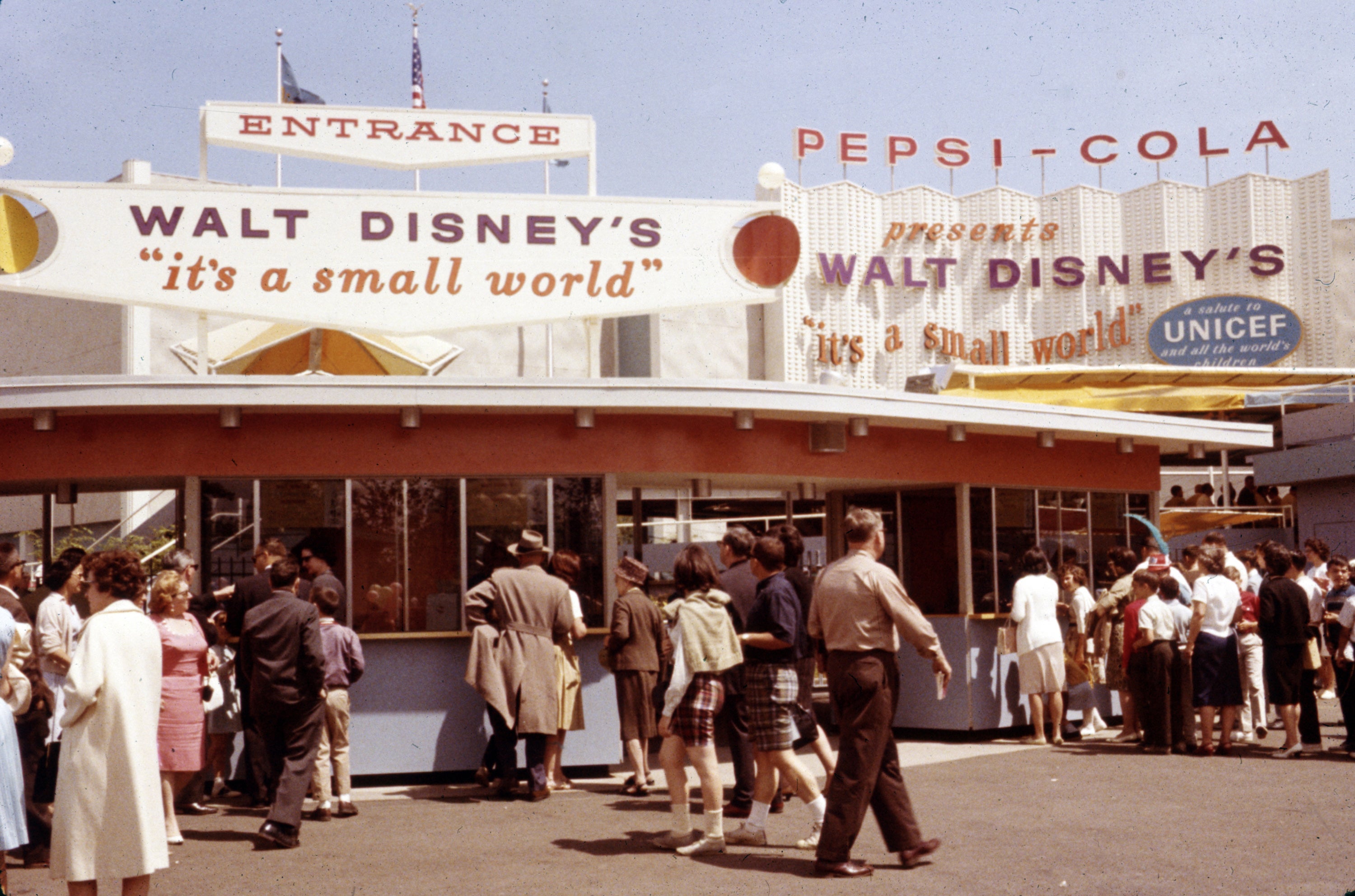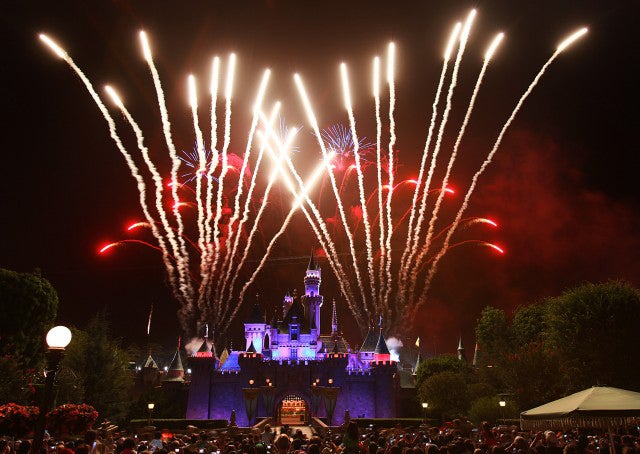A small, small, small, small world
Disneyland is more than just a tourist attraction – it’s a time capsule of the values and vision of its famous creator. Tim Walker takes a ride through the world as Walt saw it in 1955
In 1964, Walt Disney was approached by the organisers of the World’s Fair in New York to contribute an exhibit for the event’s Unicef Pavilion.
The attraction he delivered, which he named “It’s a Small World”, took visitors to the fair on a sedate, 15-minute river ride through Walt’s childlike vision of the world, populated by Irish leprechauns, Indian snake charmers, Arabs piloting flying carpets, and Italians punting gondolas. The ride was accompanied with a ditty by the Sherman Brothers, the composers of Disney musicals including Chitty Chitty Bang Bang and Mary Poppins.
It’s a Small World was such a success that it was rebuilt at Disneyland in California, where it remains to this day, a time capsule of the era and its attitudes. Almost 300 million people have visited the attraction, which celebrated its 50th birthday this month. There are facsimile Small Worlds at Disney parks in Florida, Tokyo, Paris and Hong Kong. The Shermans’ earworm plays on a loop about 1,200 times per day; I took the ride a fortnight ago and can still hear it knocking at the door of my brain, like a relentlessly cheerful room-mate I’ve been trying to get evicted.
The rides at Disneyland endure like those at no other theme park. This summer also marks the 55th anniversary of the Matterhorn Bobsleds, an Alpine-themed attraction that, when it opened in 1959, was the world’s only tube steel-track rollercoaster. It is the 45th anniversary of the Haunted Mansion, Disneyland’s seminal “dark ride”. The Big Thunder Mountain Railroad, one of very few rollercoasters I’ve ever enjoyed, turns 35 next month. None of them shows any sign of trundling off to the great theme park in the sky.
At Universal Studios Hollywood, by contrast, a 15-year-old attraction based on Terminator 2 was replaced in April by “Despicable Me: Minion Mayhem”. (A Transformers ride opened in 2012, a rollercoaster based on the Mummy franchise opened in 2004. Who knows how long they’ll last?) At Disneyland, the rides become movies: Pirates of the Caribbean was based on the beloved Disneyland attraction. Next year sees the release of Tomorrowland, a sci-fi blockbuster starring George Clooney which shares its name with Disneyland’s sci-fi-themed land and was partly shot at the California park. The director Jon Turteltaub is reportedly developing a movie based on Small World.

Designer and former Disneyland worker Mitch Thomas, who also writes the blog Imagineering Disney, grew up in southern California and visited the park regularly as a boy. Later he worked in one of its gift shops, before spending several years as a Disney “Imagineer”, responsible for maintaining the magic of the park’s classic rides. Thomas believes that what sets Disney’s rides apart is the richness of their realisation.
“The environments are completely immersive,” he says. “Other theme parks can be great, but you can always see the exit sign, the back door, or something else that doesn’t quite fit. Very few rides live up to the standards of Small World or Haunted Mansion, their artistry, charm and attention to detail. Disney created an identity for each attraction that’s difficult to compare to anything else.”
You can still ride the 88-year-old carousel in Griffith Park, close to Disney’s Burbank studios, where Walt used to take his daughters, Diane and Sharon, and where he is thought to have dreamt up the idea of a Disney theme park during the 1940s. He first envisaged a modest “Mickey Mouse Park” modelled on the likes of the Tivoli Gardens in Copenhagen, to be built on land beside the studio, where Disney Animation and ABC Studios now have their headquarters.
However, as Walt’s dream expanded, so did the necessary plot, and he eventually purchased 160 acres 37 miles away in Orange County, where Disneyland opened in July 1955. It is arguably the only major theme park in the world which is also an exhibit: a museum devoted to itself, and to the lasting vision of one man, whose ambition was to build “the happiest place on earth”. To do so, he enlisted an elite group of artists, architects, engineers and experts in other disciplines whom he dubbed Imagineers, and who between them created the varied lands of Disneyland, among them Tomorrowland, Adventureland, Frontierland and Fantasyland.

Watch Apple TV+ free for 7 day
New subscribers only. £8.99/mo. after free trial. Plan auto-renews until cancelled.
ADVERTISEMENT. If you sign up to this service we will earn commission. This revenue helps to fund journalism across The Independent.

Watch Apple TV+ free for 7 day
New subscribers only. £8.99/mo. after free trial. Plan auto-renews until cancelled.
ADVERTISEMENT. If you sign up to this service we will earn commission. This revenue helps to fund journalism across The Independent.
It is testament to the inclusive appeal of Disney parks that a third of the visitors to Disneyland in California and Walt Disney World in Florida are so-called “non-family guests”: adults without their offspring. In the sweltering SoCal heat of early August, my friend Tom and I arrived for our first-ever visit, clutching our $96 (£57) tickets and a copy of The Imagineering Field Guide to Disneyland, two grown men fearing a park packed with vacationing schoolchildren. Which it was – but it was also packed with adults.
Despite the crowds, the lines for rides were quick and efficient, the distances between them short and navigable. Adventureland abuts Frontierland, Tomorrowland abuts Fantasyland, but thanks to the scenic trickery of the Imagineers, one never encroaches on the other, so the spell is rarely broken. Every attraction tells a story: there’s narrative even in rollercoaster rides such as Thunder Mountain, and none of the shabbiness that clings to elderly attractions at lesser theme parks.

Disneyland’s attention to detail is famously unsurpassed, from the brass bat gargoyles atop the queue-control stanchions outside the Haunted Mansion, to the Mickey-shaped beignets sold at the ersatz New Orleans bakery. And there’s heritage everywhere: as we scoffed andouille sausage in New Orleans Square, our lunchtime entertainment was provided by the Royal Street Bachelors, a jazz trio who have been performing at Disneyland since 1966.
From our table, we could see the pleasure boats passing back and forth on the man-made Rivers of America: the Davy Crockett Explorer Canoes, the Mark Twain Riverboat, and the Sailing Ship Columbia – a replica of the first American ship to circumnavigate the globe. All three vessels fit Disney’s idealised rendering of US history. Frontierland is a decidedly tame version of the Wild West. New Orleans has never been as squeaky clean as New Orleans Square.
Main Street, USA, along which every visitor strolls upon entering Disneyland, is a rose-tinted reimagining of Walt’s home town of Marceline, Missouri. The buildings are designed to be slightly smaller, and therefore quainter, than the real-world ones they resemble. This is not America, it is Americana. The Imagineering Field Guide calls it “heightened reality, a design technique used to invoke feelings of nostalgia while taking some licence with history”.
The guide explains: “Heightened reality is a staple of the Imagineering toolbox, giving us the artistic licence to play more directly to our guests’ emotional attachments to certain memories and design details, rather than maintaining a strict adherence to absolute authenticity in those details.”
Small World wasn’t the only attraction Walt created for the 1964 World’s Fair. He revered Abraham Lincoln, and in New York that year he also unveiled “Great Moments with Mr Lincoln”, an audio-visual exhibit based around the biggest themes of the 16th President’s life, which now appears at the Main Street Opera House. During the 15-minute show, “Mr Lincoln” mentions the word “slavery” just once, an example of reality not so much heightened as softened: “Disneyfied”, if you will. The show climaxes with a speech delivered by an animatronic Lincoln which occupies an imaginative space somewhere between Daniel Day-Lewis and the Thunderbirds.
The park contains disappointments, and plenty of unabashed commercialism. We found the Finding Nemo Submarine Voyage closed for renovations, and an hour-long line for the Indiana Jones Adventure. The famously weird 3D movie Captain EO, featuring Bad-era Michael Jackson, had been temporarily replaced by a promotional programme for Guardians of the Galaxy.
Walt Disney died in 1966, and while most Imagineers still adhere to his values and vision for the parks, Thomas suggests there are others – perhaps in the management echelons – “who didn’t know Walt Disney, and who don’t care about the history. It’s irrelevant to them, and they think it’s not in the interests of the company to cling on to those values.”

Unlike the attractions created in Walt’s lifetime, a lot of the more modern Disneyland rides are tied to commercial movie properties, and thus subject to the shifting tides of taste and fashion. Part of the greatness of, say, the Haunted Mansion, is that it borrows the spooky atmosphere of Disney classics such as Sleeping Beauty, but retains its own timeless identity.
In The Unauthorised Story of Walt Disney’s Haunted Mansion, Disney aficionado Jeff Baham writes: “The Haunted Mansion, an attraction that Walt had planned to build in the early 1950s, is now nearly five decades old – but what’s 40 or 50 years? Consider 250 years, which is the age of some of the most confounding magic inside the Haunted Mansion…
“The ‘magic lantern’ was used to project illusions on walls as early as the late 1700s. ‘Pepper’s ghost’, a stage trick involving reflections, was used to create living, transparent ghosts in the 1800s. Disney’s own space-age robotic technology came to life in the middle of the 20th century, and digital projection and computer-controlled effects have just entered prime time this century. [The ride] utilises the best special-effects techniques from the broad history of modern live entertainment.”
If there’s one timeless aspect of the Disneyland experience that I did find jarring, it’s the unquestioning worship of Mickey Mouse. The periodic parades that wind through the park are invariably led by an employee in the costume of Walt’s most famous character. Mickey is a 20th-century creation, who exists in the 21st not as a fully rounded character such as Captain Jack Sparrow or Buzz Lightyear, but as a brand identity and a set of gift-shop ears.
Only within the small world of Disneyland, where the fantasy persists, is Mickey still the main attraction. Those noisy, packed parades wend around a statue at the top of Main Street, USA, of Walt and Mickey holding hands and looking on benevolently – still the ruler and prince of their magic kingdom.
Join our commenting forum
Join thought-provoking conversations, follow other Independent readers and see their replies
Comments